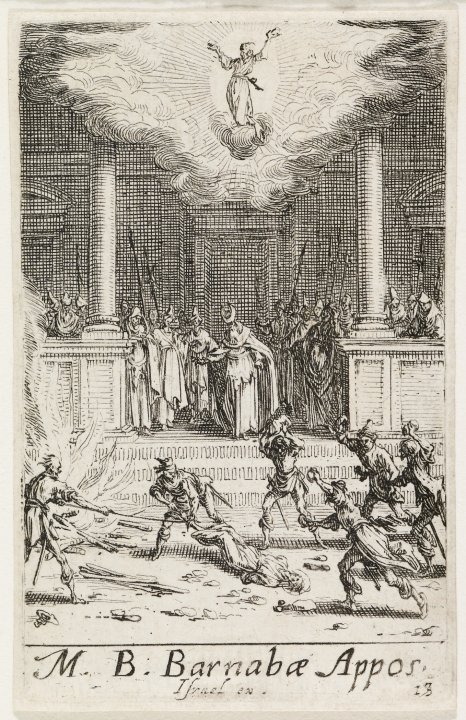The Son of Encouragement

St. Barnabas, born Joseph, was one of the most prominent disciples of Jesus and among the earliest Christian believers in Jerusalem. Traditionally regarded as one of the seventy disciples commissioned by Christ himself (Luke 10:1-12), it was Barnabas who was convinced of the validity of St. Paul’s conversion and who would end up vouching for St. Paul to the rest of the Christian Church. It is no surprise, then, that Paul and Barnabas would end up co-workers in ministry, preaching the Good News together all over Asia Minor.
Hailing from the tribe of Levi and born on the island of Cyprus (Acts 4:36), St. Barnabas is referenced in various passages in the New Testament, including St. Paul’s letters. In the Acts of the Apostles, we learn that Barnabas was a member of the church in Jerusalem who sold his riches and laid the proceeds at the feet of the apostles. We also learn that the apostles gave him the name Barnabas, meaning “Son of Encouragement,” and that he was the cousin of John Mark, the author of the second Gospel.
Finally, it is in Acts that we learn that the church in Jerusalem sent Barnabas to Antioch to assist the growing community of Christians there and that Barnabas would later bring Paul to Antioch to help him serve the church there (Acts 11: 19-32).
After their success in Antioch and return to Jerusalem, the two disciples decided to add a third person to their entourage, bringing John Mark with them in their additional travels. Yet, John Mark became discouraged and would return to Jerusalem, leaving Paul and Barnabas on their own.

It was because of this event that Barnabas and Paul would later disagree on John Mark’s role in the missionary group and his dedication to the mission, a disagreement that would cause them to split up and do their missionary work separately. Barnabas took John Mark with him back to the island of Cyprus while Paul took the disciple Silas as his companion to Syria (Acts 15:36-41).
Paul does eventually reconcile with John Mark (Philemon 24) and praise Barnabas for his work as a disciple in 1 Corinthians 9:6, an indication that Christian forgiveness was able to overcome this divide.
The circumstances of Barnabas’ death are not entirely clear, but according to Church tradition, the disciple was martyred by being stoned to death at Salamis, Cyprus, around the year 60. His cousin and colleague John Mark is said to have witnessed Barnabas’ betrayal by his own countrymen.
Within art, St. Barnabas is often depicted with St. Matthew’s Gospel in one hand (he was said to have transcribed the text) and sometimes a stone. The stone is meant to be a symbol of his martyr’s death at the hands of his fellow Cypriot Jews.
A Brief History
Like most of the commemorations of the saints, St. Barnabas’ Day falls on the day of his martyrdom, the 11th of June. On that day, the Church commemorates one of our Lord’s most well-known disciples outside the Twelve. Moreover, the Church remembers a man whose faithfulness was known enough for St. Luke to describe him as a “good man, full of the Holy Spirit and of faith” (Acts 6:24).
Since this feast falls close to the summer solstice in the Northern Hemisphere, it has historically been associated with the fact that the days around June 11th are among the longest days of the year. This can be seen in the old rhyme:
“Barnaby bright, Barnaby bright
The longest day and the shortest night.”

Collect
Almighty God, Thy faithful servant Barnabas sought not his own renown but gave generously of his life and substance for the encouragement of the apostles and their ministry; grant, we beseech Thee, that we may follow his example in lives given to charity and the proclamation of the Gospel; through Jesus Christ, Thy Son, our Lord, who liveth and reigneth with Thee and the Holy Ghost: ever one God, world without end. Amen.
Lessons
Resources
Read more about celebrating St. Barnabas in our post here!
Issues, Etc. interview with the Rev. Dr. Jeff Oschwald on St. Barnabas
Propers found in Daily Divine Service Book: A Lutheran Daily Missal, edited by the Rev. Heath Curtis
References:
1. Dickinson, William Leeson. The Lives of the Saints; or Ecclesiological and Historical Notes on the Holy Days of the English Church. The Church Printing Company. 1865.
2. Encyclopedia Britannica entry on St. Barnabas.
3. Pfatteicher, Philip H. Festivals and Commemorations: Handbook to the Calendar in Lutheran Book of Worship. Augsburg Publishing House. 1980.
4. Weedon, William C. Celebrating the Saints: The Feasts, Festivals, and Commemorations of Lutheran Service Book.Concordia Publishing House. 2016.
Images:
1. The Martyrdom of St. Barnabas from the series The Martyrdoms of the Apostles, Jacques Callot, France, 1632.
2. Paul and Barnabas at Lystra, Jacob Pynas, The Netherlands, 1628.
3. Barnabas Curing the Sick, Paolo Veronese, Italy, 1566.





Leave a Reply